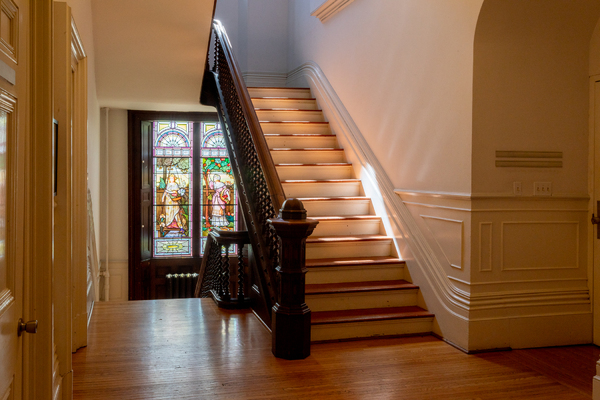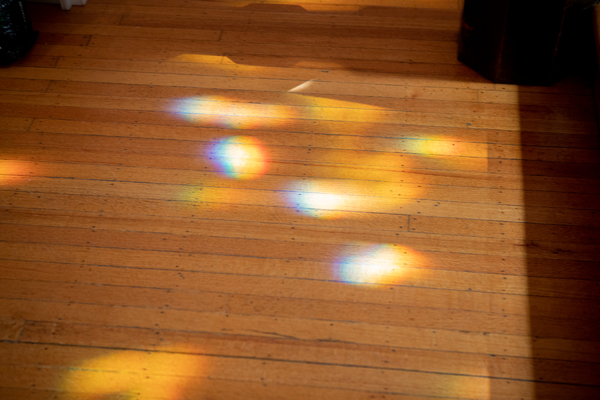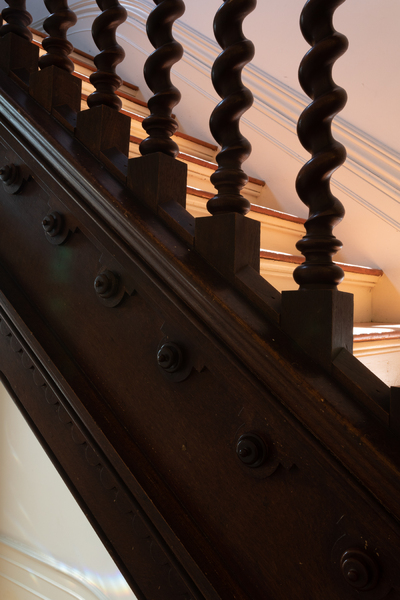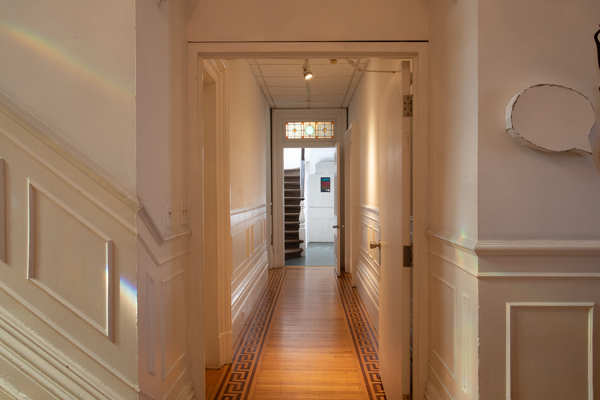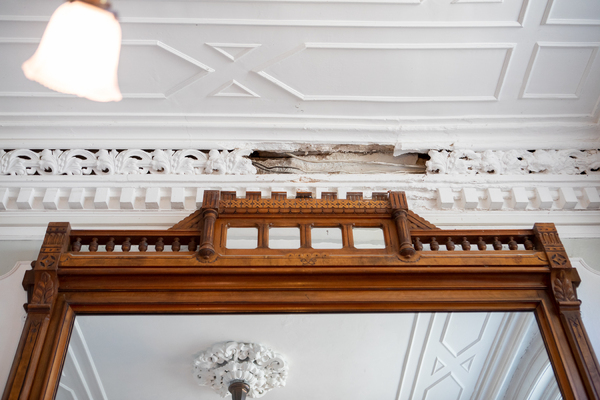CODA: Into the Forest of Signs
As one enters Rodman Hall we are greeted by the name of the exhibition: CODA along with the names of the 14 participants. Defined in the dictionary as an ending or supplement, CODA not only concludes an academic year but one also unprecedented in the challenges it posed during the COVID-19 pandemic. The previous honours exhibit was cancelled as a result of the first lockdown instituted in March of 2020, but the course directors, Professors Shawn Serfas and Donna Szőke, offered the opportunity to students from both 2019/20 and 2020/21 cohorts to participate in a combined show. The strongest impression I am left with is the deft installation of a variety of works, from acrylic or oil on canvas or panel to an upstairs room in which acrylic murals have been executed directly on the walls with markers; from photography to a more experimental vein of a photo emulsion lift; from embroidered clothing or hoops to diazo emulsion prints; from illustrated cartoons or storyboards to sculptural objects in the form of cardboard or a hanging mobile.
The Ali and Corinne Hansen Gallery which one enters to the left of the entrance vestibule is dominated by two mantled fireplaces. It reinforces the theme of the two artists –James Kershaw and Kira Pretty– who ostensibly explore aspects of the home, especially under COVID-19. Kershaw offers four paintings along with two sketch books as a homily to a more reflective life in which the mundane and personal possessions –plants and the items that make up a domestic setting– are cherished for their familiarity. Deceptively simple, Absence (2021) foregrounds an empty chair, which also conjures the metaphysical question: rather than Vincent van Gogh’s candle in his homily to Gauguin, the empty shoes signify life but also the immutable presence of loss. Kershaw pushes himself beyond the prosaic presence of a cherished plant in Eternity (2021) that signals commitment to another life form to address only what art can allow: a deeply poetic insight into memory, where regret or happiness both reside. The artist presents himself in the foreground of Wave (2019) working at his computer and in the middle ground his partner who sits on a sofa. The normalcy of the scene is disrupted by the presence of a mouse on the desk and the cat whose attention is focused on his partner. The ‘cat and mouse’ game that toys with instinct and survival is amplified as we look beyond the fenestrated glass wall to the tsunami wave that gathers momentum in the distance. Is it a nostrum for oblivion or survival, the painting asks? Most poignant, I suggest, is the small painting Now I Lay Me (2021) that reveals the view through the window of his home the artist sees as he wakes up –a hopeful image in which the rays of sunlight infusing the awaiting day and the cruciform of the window frame are discrete reminders of how we find solace in the minimal language of symbolism.
Three black and white C-prints, Unfulfilled Desire (2020) by Kira Pretty, speak to the isolation of the times. Her camera is pointed at the windows of her family home –the gauze window covering obscures our view of the central image, although hinting at what is beyond. A garden and the outline of other houses that speak of a neighbourhood are further obscured. Yet, the arched shaped window alludes to the potential elegance of the décor of what may be inside this home –details of which we are not privy to. The transition between a literal ‘inside’ and ‘out’ is suspended as we tilt on the edge of apprehension. The window is less an opening to nature or the built fabric of the neighbourhood, than a veiled impediment. What does Pretty’s reference to unfulfilled desire refer to? Is it an insight into the artist’s frame of mind, or could it be a negation of the viewer’s impulses or expectations? We are left with a fragmented point of view where the photographic frame is itself suspended or broken into partial elements in the two supporting images in what appears to be an image of the bow window through a secondary glass door. The silhouetted pine branch cannot be read with certainty in the third image –is it a partial tree viewed through the window, or is it the ornamental branch of a Christmas tree? Photography’s documentary role is disrupted by the distortions and ambiguities that cannot be fully resolved by the viewer, which makes for an engaging exchange.
Similarly, the three black and white C-prints by Kaitlin Roberts, now an MFA student at the Emily Carr University of Art + Design, posit photography as a time-based medium. The figure in let’s try this again (2020) takes on the ghosted quality of a time-elapsed image in which the subject is both fleeting and ethereal in its blurred qualities. To think of the infinite number of ways to photograph the human figure, Roberts elects to pose her figure in the bathroom where the images are generated or composed from the doorway. Process, chance and performance are each suggested in the blurred movement of the clothed female subject in eliciting an impromptu playfulness before the camera. Such an approach reminds one of the intimate self-portraits Francesca Woodman made of herself in empty, derelict rooms in Rome or Rhode Island. Here, Roberts makes the best of what may have been confining circumstances under the pandemic to create a more introspective variation of the female figure.
On the opposite wall are six drawings made from Botanical ink on paper by Aidan Frenette. They are schematic renderings of plant forms that she has identified along the banks of the Welland Canal. Although she includes their Latin names, they may be familiar to us: Reseda Lutea, Astera, Rhus Coriaria, Oryzopsis Hymenoides, Cirsium, and Daucus Carota. From medicinal uses to making dyes, from foraging sources for humans and animals alike to weeds such as Queen Anne’s Lace (Daucus Carota), these plants have dominated the underbrush, fields, wetlands and environs of the Welland Canal for centuries. They complement Frenette’s works shown in the large gallery, which also focus on other aspects of the Welland Canal and its industrial ecology.
Across the hallway beside the vestibule is a small experimental space. Carefully organized with drawings by Zach White mounted on the wall and 50 small ink illustrations from Boxed Madness (2020) by Jess McClelland displayed on the ledge running around the ornate room as well as drawings in a glass display case in the centre of the space, it presents as a shrine to the art of caricature or graffiti and the metalanguage adopted by a shrewd commentator such as McClelland who offers his skew on a range of cultural issues. His drawings are mostly accompanied by statements such as “Damn You Picasso!” which accompanies the transmogrified features of a disjointed face; “Despite Popular Belief…Owls Aren’t…That Smart”, accompanying a confused looking owl wearing a Dunce cap; and “Neverland or Bust Baby”, a classical bust with the veiled reference to the late Michael Jackson’s estate and the Roman marble bust in his collection. Irony is peppered with guile and cunning. The piece In Dreams (2020) which exemplifies the strip cartoon in its presentation, begins sceptically with the idea that the subject does not believe in ‘dream interpretation’, and continues by revealing his innermost fears or anxieties. There appears to be a self-portrait in the centre of the ink drawings in the glass display case, which shows the artist at work, or at least in contemplation with cigarette in hand –a more dignified escape from the monsters of his In Dream piece. White’s approach is different from although equally influenced by graffiti. His mark making seems to express the flow of his subconscious. The works simply titled from Number One to Number Eight, exemplify a capacity to fill the frame of the page with abstract or idiomatic motifs that morph from one form into another, head after head, gaping after grinning mouth, eye after eye, each emblazoned with check, floral or reptilian patterns.
On climbing the stairs to the 3rd floor studio where Zack White’s mural fills all four walls, one encounters a kaleidoscopic experience which he titles Blast Off. The idea of horror vacui is in play as every surface is covered with intricate motifs, of which the eye is the most prominent feature in his bio-morphic, zombie creations that project throughout the space. Partial words or phrases suggest how language is disassembling or reassembling; the catch phrase “It is what it is?” is turned into a question. Coming back down on the first landing are three canning jars that hold drawings by White on acetate and are illuminated by the sunlight; they are suddenly meaningful as one turns onto the next landing where the pair of stained-glass windows dating to the 1880s are installed. These symbolize the kind of fecundity associated with the harvest or nature’s bounty. The lucid red, blue and yellow hues of White’s drawings are picked up in the exquisite colours of the stained-glass windows. Red suddenly transforms into a basket of apples or peonies, blue into pansies and yellow into oval sunbursts.
The connection to the floral-themed oil paintings downstairs by Chardon Trimble-Kirk is also there to be seen. The poppy leaves in the stained-glass windows easily translate into the plant types she paints as part of her Vibrancy series (2019-20), although these are more the hardy succulents or cacti grown for dry arid conditions but marketed for indoors. Her installation titled Intimacy (2019-20) is a mobile of a series of hands and fingers whose outlines are delicately embroidered onto circular hoops. At the point of contact and with intertwined fingers or hands, she highlights the intimacy of touch with silver or pink thread to reinforce the physical bond. If, typically, indoor plants are dependent on us to water and sustain them, relationships require as much if not more. Her three large panels which she titles Growth (2020-21) on the other side of the room show plant forms outlined with coloured rope on a dark background; tulips or bulbs can be made out.
Next door, intimacy is transported into a vestigial palace of male phallic display by Renz Baluyot. Combinations of acrylic panels objectify the male organ in graphic terms. Erect or post coital the penis is often emblematic of sexual pleasure and in this instance, also of camp erotica. The flatly painted figures are scantily clad with athletic wear and sometimes emblazoned with bold patterned backgrounds. None of this deters from the fixation the artist has for engorged members, which also telegraphs in a more developed work such as Fried Twinky Queen Dream (2020) to a clever form of irony where popular idioms of consumption have been subverted by gay porn. Other titles such as Fruit of the Elven Loom (2021) explore the realm of gay sexual desire where Baluyot’s Pop sensibility lends a veneer of sentimentality to the bacchanal.
The main gallery is presented as a space where the three large format, abstract canvases by Curt Richard are in contention with all else in the space. One is drawn to their strong colours and to the moments that produce small epiphanies from their abstract vein. For example, in Gallons of Rubbing Alcohol Flowing Through the Strip (2020) the dramatic, light green swipe that appears magically alongside the pink field is reminiscent of Gerhard Richter’s technique and asserts itself over the dominant mottled blue fissure that holds the centre canvas. If we look attentively to the other areas where this filigree of green appears --a subtle, angled stripe on the lower right and above as it accentuates a black curved motif that is also frayed on the underside, we see a distinct calligraphy appear. Here, as in the other two canvases, the black shapes or curved outlines are definitive in form and stricture, especially when set in motion by the agitated colour field, be it the yellow of Beauty (2020) or the blue of I Am the Anti-Pop (2020).
Rachel McCartney’s three vertically stacked canvases explore the theme of water. Typhoon (2021) is a study in tonal variation, with its rippled rather than heaving surface and air bubbles suggesting a fully immersive experience. Her deft touch suggests a controlled approach to an otherwise powerful natural event. She opts for an elevated perspective in the next panel titled Laguna (2021) which shows a female swimmer entering the frame and pushing forward. The third in the series titled Riptide (2021) introduces a more pronounced danger in that her swimmer appears to be pulled beneath the surface. Here, the full drama of the sequence is felt as the figure is caught in her struggle for breath, and perhaps life itself.
Across the room on the other side are paintings by Rea Kelly. They draw attention back to the human condition, less the figure than a psychological reckoning –floating ghoulish heads that signal an anxiety in each of us. This is portraiture unhinged from its representational role and instead charged with the electricity of the dream state and the darkness from which these mask-like entities emerge. If they recall the rituals of spirit dances or the Neo-expressionist works of Francesco Clemente or Susan Rosenberg, they are confident monikers in their ability to conjure a viscous vitality on recycled canvases. Teeth (2021) is vivid in its display of emotion and fleeting imagery (is it three or four heads?), which reminds this writer of popular cinematic memes such as the Joker in the 2019 film as played by Joaquin Phoenix who exudes a manic vitality on the screen. Kelly has the ability to transfix the viewer with her heavy pigmented colour, emphatic characterization and bold gestures. Don’t Look (2021) is a ghoulish composition in which four figures are mesmerized by the manifestation of a floating apparition –while this cannot be confused with noumenal life, it cloys at our psyche.
The two other installations in the main gallery by Lillian Pasqua and Aidan Frenette lend a calming effect to the vitality of the room’s paintings. Pasqua presents a variation on the menagerie with her several white cotton items of clothing and her prints of moths and plant life. On closer inspection one discovers the beautiful delicacy of her use of thread --two bark-coloured sprigs of budded cherry blossom embroidered on the cuff of a jacket hung over the chair in the foreground; an exquisite plant form, ever so loosely attenuated to a cotton shirt that could be a web formed by the beetle on another shirt, or an absent spider. The delicate balance between nature and artistry is explored to the fullest with Pasqua’s four tools exhibited to the left of the installation in a poetic gesture to a ‘sound of its own making’. Each of her nearly twenty items is labelled individually and shows how individual components can lend vitality to an assembled whole.
A similar delicacy is exhibited by Frenette’s wall in which she discovers the by-product of an inert process. If the photographic process is used typically to document and reveal truths about the objective world, here Frenette employs the photo emulsion lift as both abstracted image and artifact. Floated within a series of resin frames, and if studied closely enough we may begin to see an image unfolding from the delicate but unruly light sensitive emulsion. With the inclusion of Stasis (2021), two blown up C-type versions –in effect documentation— we can see how photography is as much a practice in macrocosms as it is ethereal resonances. Her triptych Port Weller (2021) takes a tangible motif, in effect a major industrial marker and subjects it to the chemical stresses of the C-type process to render it both ethereal and real in the way Roland Barthes described the photograph as a paradox between the past and the present. Yet, the technological sublime that the Welland Canal symbolizes is forsaken for a more ephemeral, floating existence; ships appear and disappear, but the engineered infrastructure dominates the rural landscape. The artist focuses on a form of aphasia, a conditioned forgetfulness that obviates the larger, overwhelming hulk of the ships in favour of smaller almost imperceptible details. Such trace elements are consistent with her prints in the front gallery which now read like a codicil over the fireplace –in effect six images of flora scribed with their Latin names.
The hallway that marks the threshold between the front galleries of the original building and the back where the large addition houses the main gallery is a transitional space with the work of Brianne Casey, now an MFA student at Western University. Her paintings engage the idea of cosmic catastrophe, seemingly deep probes into space –her titles Toxic Universe (2019), Catastrophe (2019) and Viral World (2019) conjure the despair that many have felt this past year not only in terms of a global epidemic, but also caused by issues connected with the environment, global warming, the migration crisis in the Mediterranean or the US-Mexico border, and conflict in the Middle East or Asia. In exploring the metaphoric power of a title Casey aligns painting with the topical issues of the day, or at least a state of mind, although her abstract canvases are non-specific in their galactic schema –we catch the outline of a lighthouse at the centre of Toxic Universe but all else revolves around this mechanical sun in a swirl of vivid fluorescents. Yet, Untitled (2021) which hangs separately on a feature wall is a study of a truncated fir tree which metamorphosizes from is natural state into a framed painting. Is this an example of art triumphing over nature, where idealized states of being can be indulged? Cultural memory is compellingly strong, especially where nature is concerned in Canada, and Casey addresses this on her own terms in acrylic on wood panel. Admittedly enigmatic, it drives to the heart of the paradigmatic image, whether Emily Carr or Jeff Wall, and re-envisions the exoticization of nature.
Finally, Taylor Sorenson presents days after (2021), a video installation accompanied by a series of C-prints in the small vestibule adjacent to Casey’s paintings. In basing her aesthetic response to her interaction with the World Wide Web I am struck by the interplay between the computer and its modes of communication. In addition to a screen on which she programs a repetitive action, a process that appears to replicate the sourcing of digital images from the immutable flow of the image hive, she also reproduces a series of small hand drawn images that she photographs. These are emblematic of both human and machine vision where the overlaid pattern of digitized tiling (glitches?) are combined with drawings of human features emphasizing eyes and brains. The 404 error code appears over two her drawings, which begs the question of how we are to read such a broken connection: is it a simple error, or is it something more ominous?
Derek J.J. Knight
Associate Professor, Visual Arts
Brock University
